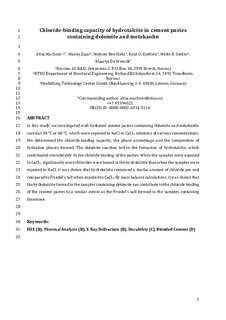| dc.contributor.author | Machner, Alisa | |
| dc.contributor.author | Zajac, Maciej | |
| dc.contributor.author | Ben Haha, Mohsen | |
| dc.contributor.author | Kjellsen, Knut Ose | |
| dc.contributor.author | Geiker, Mette Rica | |
| dc.contributor.author | De Weerdt, Klaartje | |
| dc.date.accessioned | 2019-02-13T14:38:31Z | |
| dc.date.available | 2019-02-13T14:38:31Z | |
| dc.date.created | 2018-08-15T14:36:02Z | |
| dc.date.issued | 2018 | |
| dc.identifier.citation | Cement and Concrete Research. 2018, 107 163-181. | nb_NO |
| dc.identifier.issn | 0008-8846 | |
| dc.identifier.uri | http://hdl.handle.net/11250/2585293 | |
| dc.description.abstract | In this study, we investigated well-hydrated cement pastes containing dolomite and metakaolin cured at 38 °C or 60 °C, which were exposed to NaCl or CaCl2 solutions of various concentrations. We determined the chloride-binding capacity, the phase assemblage and the composition of hydration phases formed. The dolomite reaction led to the formation of hydrotalcite, which contributed considerably to the chloride binding of the pastes. When the samples were exposed to CaCl2, significantly more chlorides were bound in the hydrotalcite than when the samples were exposed to NaCl. It was shown that hydrotalcite contained a similar amount of chloride per mol compared to Friedel's salt when exposed to CaCl2. By mass balance calculations, it was shown that the hydrotalcite formed in the samples containing dolomite can contribute to the chloride binding of the cement pastes to a similar extent as the Friedel's salt formed in the samples containing limestone. | nb_NO |
| dc.language.iso | eng | nb_NO |
| dc.publisher | Elsevier | nb_NO |
| dc.rights | Attribution-NonCommercial-NoDerivatives 4.0 Internasjonal | * |
| dc.rights.uri | http://creativecommons.org/licenses/by-nc-nd/4.0/deed.no | * |
| dc.title | Chloride-binding capacity of hydrotalcite in cement pastes containing dolomite and metakaolin | nb_NO |
| dc.title.alternative | Chloride-binding capacity of hydrotalcite in cement pastes containing dolomite and metakaolin | nb_NO |
| dc.type | Journal article | nb_NO |
| dc.type | Peer reviewed | nb_NO |
| dc.description.version | acceptedVersion | nb_NO |
| dc.source.pagenumber | 163-181 | nb_NO |
| dc.source.volume | 107 | nb_NO |
| dc.source.journal | Cement and Concrete Research | nb_NO |
| dc.identifier.doi | 10.1016/j.cemconres.2018.02.002 | |
| dc.identifier.cristin | 1602232 | |
| dc.description.localcode | © 2018. This is the authors’ accepted and refereed manuscript to the article. Locked until 20.3.2020 due to copyright restrictions. This manuscript version is made available under the CC-BY-NC-ND 4.0 license http://creativecommons.org/licenses/by-nc-nd/4.0/ | nb_NO |
| cristin.unitcode | 194,64,45,0 | |
| cristin.unitname | Institutt for konstruksjonsteknikk | |
| cristin.ispublished | true | |
| cristin.fulltext | postprint | |
| cristin.qualitycode | 2 | |

